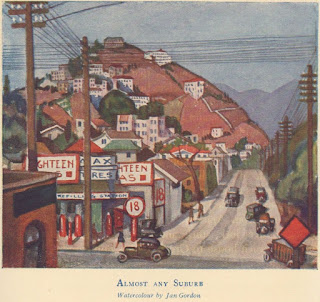Reviews of Jan Gordon's "A Girl in the Art Class"
The Observer (1927, March 6th) published a review of "A Girl in the Art Class" (Hutchinson, 7s. 6d.) under the title "An Artist's Novel," noting how the author's knowledge of art adds to the sense of authenticity. Other reviews made the same observation and included the following.
"Jan Gordon's story has all the stamp of the real thing. A clever presentation of an instinct-personality. Raymonde Carpenter gives some delicious little sketches of her fellow students and their eccentricities. They strike one as having been done from life." Evening Standard.
"Vivid and veracious story. The standards of morality freely set forth will be amazing to the respectable ... nearly all have free views of sex" - English Review
"This book strikes one as a very true picture of the Artist life .... You can hear all Jan Gordon's characters talking." - The Queen.
"The studio life in Paris is written by one who knows it well and can go below the surface." - Daily Express
"We are kept interested from beginning to end in a human experience of art classes, studio parties, eccentric characters ... her (the heroine's) adventures in Paris are fascinating." John O' London's Weekly.
The book is clearly only a very thinly disguised biographical work, as are a number of Jan Gordon's other pieces, and the "They strike one as having been done from life" comment above is perceptive. Characters and places can be deciphered, including "The Praps" and of course Jan and Cora Gordon themselves.
The Yorkshire Post and Leeds Intelligencer of Wednesday 23 March 1927 carried the following review under the title of "Art and Youth":
"Mr. Jan Gordon’s last novel (“A Girl in the Art Class,” Hutchinson, 7s. 6d. ) deals with the early life of Raymonde Carpenter as an art student in London and Paris. Raymonde is the daughter of a “daffodil breeder” with a narrow outlook on life, and in consequence his daughter is brought up in ignorance of its many mysteries. A quarrel with her father induces her to leave home and try her luck in London. She joins an art school, but the “cut and dried” method of teaching art stifles her individuality, although in theory she leaves the school a “qualified” artist. Raymonde’s decision to go to Paris was prompted by the desire to regain her lost artistic sense. She does so, but just when success is about to smile on her she meets William Arnold. They fall in love, and Raymonde, ignoring the possibilities of a successful artistic career, agrees to marry William. The reader is left to assume that “they lived happily ever afterwards.”
There is little plot in Mr. Gordon’s story, but it is evident that the author has an intimate knowledge of the life of artists in England and France. Moreover he writes pleasantly, and all his characters are well portrayed. It is refreshing to meet a heroine like Raymonde; she is thoroughly unsophisticated and innocent – and, above all, she is able to think the best of everyone that she meets.”
"Jan Gordon's story has all the stamp of the real thing. A clever presentation of an instinct-personality. Raymonde Carpenter gives some delicious little sketches of her fellow students and their eccentricities. They strike one as having been done from life." Evening Standard.
"Vivid and veracious story. The standards of morality freely set forth will be amazing to the respectable ... nearly all have free views of sex" - English Review
"This book strikes one as a very true picture of the Artist life .... You can hear all Jan Gordon's characters talking." - The Queen.
"The studio life in Paris is written by one who knows it well and can go below the surface." - Daily Express
"We are kept interested from beginning to end in a human experience of art classes, studio parties, eccentric characters ... her (the heroine's) adventures in Paris are fascinating." John O' London's Weekly.
The book is clearly only a very thinly disguised biographical work, as are a number of Jan Gordon's other pieces, and the "They strike one as having been done from life" comment above is perceptive. Characters and places can be deciphered, including "The Praps" and of course Jan and Cora Gordon themselves.
The Yorkshire Post and Leeds Intelligencer of Wednesday 23 March 1927 carried the following review under the title of "Art and Youth":
"Mr. Jan Gordon’s last novel (“A Girl in the Art Class,” Hutchinson, 7s. 6d. ) deals with the early life of Raymonde Carpenter as an art student in London and Paris. Raymonde is the daughter of a “daffodil breeder” with a narrow outlook on life, and in consequence his daughter is brought up in ignorance of its many mysteries. A quarrel with her father induces her to leave home and try her luck in London. She joins an art school, but the “cut and dried” method of teaching art stifles her individuality, although in theory she leaves the school a “qualified” artist. Raymonde’s decision to go to Paris was prompted by the desire to regain her lost artistic sense. She does so, but just when success is about to smile on her she meets William Arnold. They fall in love, and Raymonde, ignoring the possibilities of a successful artistic career, agrees to marry William. The reader is left to assume that “they lived happily ever afterwards.”
There is little plot in Mr. Gordon’s story, but it is evident that the author has an intimate knowledge of the life of artists in England and France. Moreover he writes pleasantly, and all his characters are well portrayed. It is refreshing to meet a heroine like Raymonde; she is thoroughly unsophisticated and innocent – and, above all, she is able to think the best of everyone that she meets.”



Comments
Post a Comment